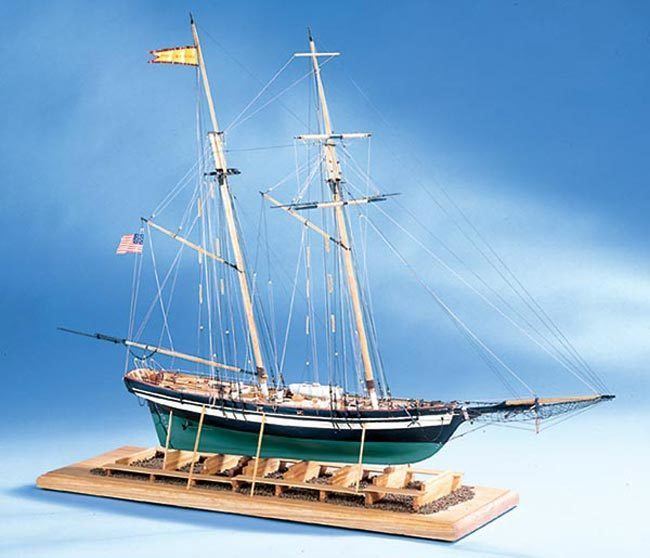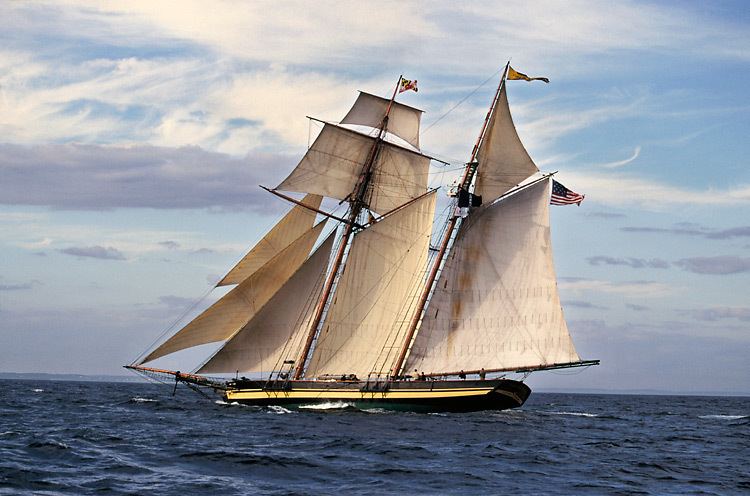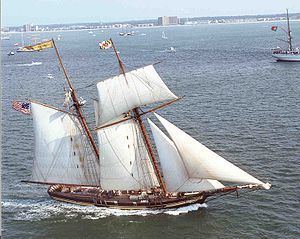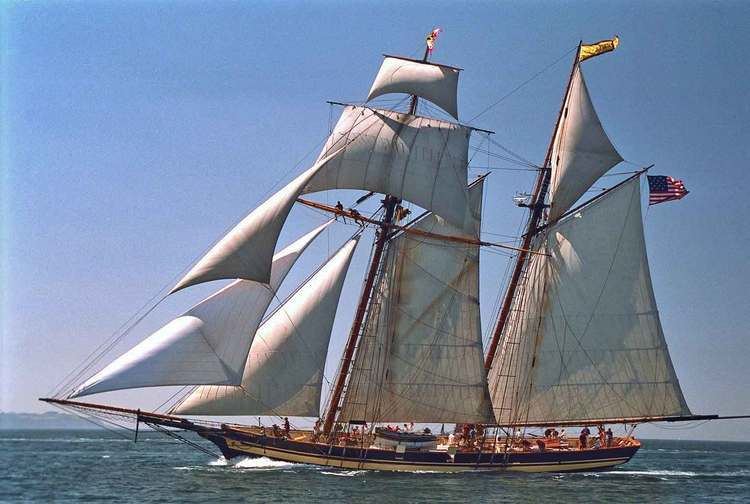Laid down April 1976 Commissioned May 1, 1977 Length 48 m Draft 2.97 m Beam 7 m | Launched February 27, 1977 Construction started April 1976 Weight 129 tons Hull material Wood | |
 | ||
Builders International Historical Watercraft Society, Melbourne Smith Similar USS Niagara (1813), Picton Castle (ship), Roseway | ||
Nicole rush visits the new pride of baltimore sailing vessel in tampa
The Pride of Baltimore was a reproduction of a 19th-century Baltimore clipper topsail schooner, a style of vessel made famous by its success in the War of 1812. Commissioned on May 1, 1977 by Mayor William Donald Schaefer of Baltimore City and the State of Maryland, she spent nine years at sea logging over 150,000 miles, equivalent to six times around the globe. On May 14 1986 Pride of Baltimore was lost at sea, her Captain and three of the crew did not survive.
Contents
- Nicole rush visits the new pride of baltimore sailing vessel in tampa
- Sailing the pride of baltimore ii
- Chasseur The inspiration for the Pride of Baltimore
- Baltimores Renaissance Begins
- Construction and service
- Sinking
- A New Beginning
- Construction and Service
- References

The Pride of Baltimore II was commissioned as the successor and memorial to the Pride in 1988, sailing in the same Goodwill Ambassador role. Pride II has sailed nearly 200,000 miles and visited over 200 ports in 40 countries.
Sailing the pride of baltimore ii
Chasseur: The inspiration for the Pride of Baltimore

The Pride of Baltimore was built as an authentic reproduction of a nineteenth-century Baltimore clipper Topsail schooner. She was not patterned after any particular vessel, but was rather designed as a typical Baltimore Clipper of the type in its heyday. She was indirectly named for the Baltimore-built topsail schooner Chasseur sailed by the privateer Thomas Boyle - Chasseur was known as the "Pride of Baltimore" and participated in the War of 1812.
One of the most famous of the American privateers, Captain Thomas Boyle sailed Chasseur out of Fells Point, where she had been launched from Thomas Kemp's shipyard in 1812. On his first voyage as master of Chasseur in 1814, Boyle sailed east to the British Isles, where he harassed British shipping and sent a notice to George III by way of a captured merchant vessel declaring that the entire British Isles were under naval blockade by Chasseur alone. Despite its implausibility, this boast caused the British Admiralty to call vessels home from the American war to guard merchant ships sailing in convoys. Chasseur captured or sank 17 vessels before returning home to Baltimore on 25 March 1815. Perhaps her most famous accomplishment was the capture of the schooner HMS St Lawrence.

On the Chasseur's return to Baltimore, the Niles Weekly Register dubbed the vessel, her captain, and crew the "pride of Baltimore" for their achievement.
Baltimore’s Renaissance Begins

In 1975, after many years of slow decay and decline, Baltimore was struggling to reinvent itself as the center of business and commerce that the city had been previously. The old piers around the Inner Harbor had been cleared and a Promenade built around the water's edge. Citizens were beginning to discover that the harbor could become a magnet for people and recreation, as it had once been a magnet for shipping and trade. But something was still missing - a symbol, a trademark, an icon to link Baltimore to its harbor.
City officials cast about for possibilities and an idea eventually emerged that captured the theme. Former Mayor William Donald Schaefer credits then Housing Commissioner Bob Embry with the idea "Let's build a ship in the Inner Harbor to draw folks downtown." With that seminal thought, a great sailing adventure and tradition was launched that would soon catapult Baltimore back into the imagination of the nation and the world as the home of adventurous seamen and romantic ships. A name was soon selected, a choice so natural as to be almost automatic - Pride of Baltimore. The name captured the spirit of the phoenix-like town. It also tapped into her maritime heritage since "Pride of Baltimore" was the nickname of Chasseur, the largest and boldest of the legendary, Baltimore-built topsail schooners that helped win the War of 1812, a conflict that first launched the city as a commercial and maritime center.
Construction and service
In 1975, the City of Baltimore adopted a proposal from Charles Center-Inner Harbor Management for the construction of a replica sailing vessel as a centerpiece of the redevelopment of its Inner Harbor. The city requested proposals for "an authentic example of an historic Baltimore Clipper" to be designed and built using "construction materials, methods, tools, and procedures... typical of the period."
A topsail schooner design by Thomas Gillmer was chosen, and master shipwright Melbourne Smith oversaw the construction of the vessel next to the Maryland Science Center on the shoreline of the Inner Harbor. During construction, residents and visitors could watch the craftsmen working with tools and techniques of two centuries earlier. Congresswoman Barbara Mikulski performed the launching ceremonies on February 27, 1977, only 10 months after the start of construction. Mayor William Donald Schaefer commissioned the Pride of Baltimore on behalf of the citizens of Baltimore and Maryland two months later on May 1, 1977.
The Pride sailed over 150,000 nautical miles (280,000 km) during her nine years of service, visiting ports along the Eastern Seaboard from Newfoundland to the Florida Keys, the Great Lakes, the Caribbean and the West Coast from Mexico to British Columbia. She visited European ports across the Atlantic in the North Sea, the Baltic Sea and the Mediterranean.
Sinking
On May 14, 1986, a microburst squall, possibly a white squall, struck the Pride while she was returning from the Caribbean, 250 nautical miles (463 km) north of Puerto Rico. Winds of 80 knots (150 km/h; 92 mph) hit the vessel, capsizing and sinking her. Her captain and three crew were lost; the remaining eight crewmembers floated in a partially inflated life-raft for four days and seven hours with little food or water until the Norwegian tanker Toro came upon them and rescued them.
A memorial on Rash Field in Baltimore's Inner Harbor memorializes the Pride's lost captain and crewmembers (Armin Elsaesser 42, Captain; Vincent Lazarro, 27, Engineer; Barry Duckworth, 29, Carpenter; and Nina Schack, 23, Seaman).
A New Beginning
After the sinking of the original Pride of Baltimore the Board of Directors of the non-profit company that operated Pride for the City were reluctant to build a replacement, but an outpouring of unsolicited financial support from the public forced the Board into going forward with a new ship. By late summer of 1986, plans for a replacement were under way. The ship was to be named Pride of Baltimore II and serve as a sailing memorial to the original Pride. She was to be another Baltimore Clipper topsail schooner that would continue the mission of the first ship. With an insurance payment of just under $500,000, a state grant of $1 million, and contributions from private citizens, students, corporations, and foundations of over $2.5 million, sufficient funds were available to build a new ship and endow an operating fund.
Construction and Service
Thomas Gillmer was once again commissioned as designer and supervising architect. Peter Boudreau, one of the builders and captains of the original vessel, was named as master shipwright and builder. Guided by the experience of the original Pride, the Board determined that this vessel could better fulfill the mission of Globe-trotting Ambassador that had evolved over the years if she was larger and had more cruising range both under sail and under power. It was also determined that Pride II would be licensed by the US Coast Guard as a subchapter "T" vessel approved for carrying passengers. With these guidelines in hand, designer Gillmer set out to create a new Pride that would look much like the original on the outside but have more contemporary amenities and safety features below deck.
Like the original Pride, the Pride II is not a replica of a specific vessel, and, although it represents a type of vessel known as a Baltimore Clipper, it was built to contemporary standards for seaworthiness and comfort but like its predecessor, is a topsail schooner. On May 3, 1987, the keel was laid in Baltimore's Inner harbor, and Pride of Baltimore II soon began to take shape. The keel and all the other framing and planking materials were shaped out of Central American hardwoods from Belize. On this ship, modern power tools and techniques were used to speed construction. When onlookers periodically opined that "Them 19th century shipbuilders sure didn't use no kinda power tools," shipwright Leroy Suroski correctly pointed out, "They woulda if they woulda had 'em."[1] Built in the iconic Baltimore Clipper style Pride II has heavily raked masts, and has 10 sails, she carries two large gaff sails (one on a boom and one loose-footed), a main gaff topsail, three headsails, and a square topsail and flying topgallant on the foremast. Also rare on modern traditional sailing vessels, she flies studding sails (stun's'ls), additional sails set along the edge of the square topsail and the mainsail on temporary spars known as stun's'l booms. Additionally Pride II carries a very unusual sail known as a ring-tail, set like a studding sail it extends from the main boom to the main gaff.
On September 5, 2005, the Pride of Baltimore II suffered a complete dismasting while sailing in a squall in the Bay of Biscay off the coast of France. The ship returned to port under motor power for repairs.
Until 2010, the Pride of Baltimore II was owned by the citizens of the state of Maryland and operated by Pride of Baltimore, Inc., a private, nonprofit organization. Ownership was transferred to the ship's nonprofit operator with unanimous approval by Maryland's Board of Public Works on June 9, 2010.
